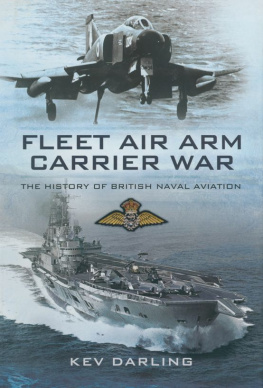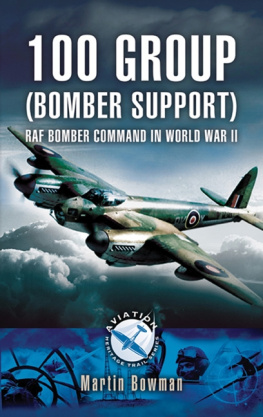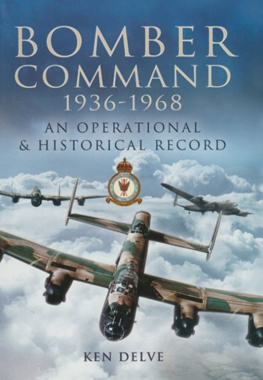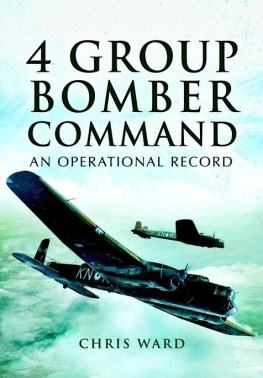
First published in Great Britain in 2012 by
Pen & Sword Aviation
an imprint of
Pen & Sword Books Ltd
47 Church Street
Barnsley
South Yorkshire
S70 2AS
Copyright Kev Darling 2012
Hardback ISBN: 978 1 84884 898 6
eISBN 978 1 78337 854 8
The right of Kev Darling to be identified as author of this work has been asserted by him in accordance with the Copyright, Designs and Patents Act 1988.
A CIP catalogue record for this book is available from the British Library.
All rights reserved. No part of this book may be reproduced or transmitted in any form or by any means, electronic or mechanical including photocopying, recording or by any information storage and retrieval system, without permission from the Publisher in writing.
Typeset in 11pt Ehrhardt by
Mac Style, Beverley, E. Yorkshire
Printed and bound in the UK by CPI Group (UK) Ltd, Croydon, CRO 4YY
Pen & Sword Books Ltd incorporates the Imprints of Pen & Sword Aviation,
Pen & Sword Family History, Pen & Sword Maritime, Pen & Sword Military, Pen
& Sword Discovery, Wharncliffe Local History, Wharncliffe True Crime,
Wharncliffe Transport, Pen & Sword Select, Pen & Sword Military Classics, Leo
Cooper, The Praetorian Press, Remember When, Seaforth Publishing
and Frontline Publishing.
For a complete list of Pen & Sword titles please contact
PEN & SWORD BOOKS LIMITED
47 Church Street, Barnsley, South Yorkshire, S70 2AS, England
E-mail: enquiries@pen-and-sword.co.uk
Website: www.pen-and-sword.co.uk
Introduction
W hen Bomber and Fighter Commands were shoehorned together many thought that this particular marriage would not work. Fortunately for Britains defence Strike Command would play its part well. This book is dedicated to those men and women that made Strike Command function: to the aircrew, some of whom lost their lives on active service, the ground crew who stopped the foregoing being no more than an expensive walking club and to all those support personnel who could supply anything from a bolt to a boiled egg, frequently at very short notice. I count myself lucky to have served alongside many of them.
Like most military organizations the command was subject to financial stringencies, some were imposed by politicians looking to further their own agendas while others occurred due to the cost of new equipment. The latter increased in price due to the complexity of emerging technologies, although once proven they would remain in service; sometimes well past their sell by date. Possibly the low point in the history of Strike Command would come in the mid-1970s when, due to financial stringencies, morale was at an all time low. Fortunately NATO came to the rescue with its insistence that all countries adopt a low profile for their aircraft and their support infrastructure. Extra money had to be found to carry out this task, and fortunately it was.
With nearly everything painted green the old routine of training for a war that no one hoped would happen was resumed, although it was rudely interrupted by the Falklands War in 1982. This revealed a few deficiencies in equipment that were quickly dealt with while the type of training carried out by all personnel was mostly vindicated. New equipment was also coming on stream; the Sepecat Jaguar was settled in service, and new versions of the Harrier were being developed, while the Panavia Tornado was starting to enter service. The service also said farewell to some old favourites such as the Avro Vulcan that had performed so well during the Falklands War.
The fall of the Berlin Wall and the collapse of communism in November 1989 led the leaders of the West to declare a misguided peace dividend. There followed a short period of base closures, cancelled programmes and personnel being made redundant. Much of this would be put on hold in August 1990 when Iraq invaded Kuwait; the author first heard this news courtesy of the BBC World Service at 30,000 feet on the flight deck of Tristar ZE705 en route to Mount Pleasant from Ascension Island. The worlds response was impressive; not only would all the nations of the West band together, they were quickly joined by the Arab nations in the region. The premise behind the war was not only to establish complete air superiority, but to use massive air power to destroy and thoroughly demoralize the Iraqi forces. Not only was this successful, it also allowed the ground forces to carry out their counter invasion with little let or hindrance.
During the remaining seventeen years of Strike Commands existence the squadrons have hardly had time to draw breath between conflicts before packing up and moving onto the next conflict. Not bad for an organization formed to protect Britain against one particular enemy. Unfortunately, the chosen name for the replacement organization was the rather anonymous Air Command. Would Air Expeditionary Command have been better and more accurate?
Obviously, such a work as this requires the help of others even though it is but a primer on the subject. Therefore, I would like to thank my old friends Bob Archer and Robbie Shaw for their help with illustrations. I would especially like to thank my old friend and boss Wing Commander Mel James for his assistance with Operation Corporate information and photographs.
Kev Darling
Wales 2012
Chapter 1
Fighter Command the Final Decade
A s the day dawned bright and sunny over the airfields of Britain little did those who scurried to work on that Friday realize that ten years from 30 April 1958 the command that had won the Battle of Britain would cease to exist. Thus as shift bosses chivvied their troops into hangars and onto the flight line, as young pilots dreaming of derring-do entered the briefing rooms daydreaming of future glories, little did they realize that some of them would be in senior positions to take the nascent Strike Command into the future.
Fighter Command had embraced the jet fighter with alacrity very early on in its career. Success with the Gloster Whittle powered by a Whittle/ Power Jets centrifugal engine on 5 March 1943 had led to the development and deployment of the Meteor F1 to Specification F9/40. Production deliveries of the first production machines, later to be named Meteor, took place in July 1944, No. 616 Squadron being the recipient. Powered by Welland engines, the new fighter was deployed on V-1 Doodle Bug interception patrols. Codenamed Diver these flights took place from Manston with the unit scoring its first success in August. While much of the squadron remained in Britain one flight was detached to Nijmegen in the Netherlands, although the Meteor was banned from flying over enemy territory thus two of the significant aircraft in jet aircraft development failed to meet in combat. The deployment lasted throughout January 1945, this first version of the Meteor being withdrawn from use soon afterwards.
This first venture in to the realm of the jet fighter was followed by the Meteor Mk 3 whose various improvements included higher thrust and more reliable engines, a ventral fuel tank, plus a sliding canopy. No. 616 Squadron would be the first recipient with No. 504 gaining their complement soon afterwards. The follow-on would be the Meteor F Mk 4, this being the first version to enter mass squadron service, a total of twenty-four units being thus equipped. No. 92 Squadron would be the first to equip in May 1948 while based at Duxford whereas No. 245 Squadron would achieve a measure of fame when some of their machines were fitted with in-flight refuelling probes for aerial refuelling trials.
Having delivered three versions of the Meteor to the Royal Air Force, Glosters would then go on to manufacture the most prevalent model, the Meteor F Mk 8, a total of 1,079 aircraft being delivered. In contrast with the earlier machines this version featured an extended nose, clipped wings, modified tail unit and a Martin-Baker ejection seat. At its height the F8 equipped thirty squadrons, including ten assigned to the Royal Auxiliary Air Force. The final front-line Meteor F8 was retired by No. 245 Squadron in April 1957 having flown various marques of the Meteor continuously from August 1945.
Next page















